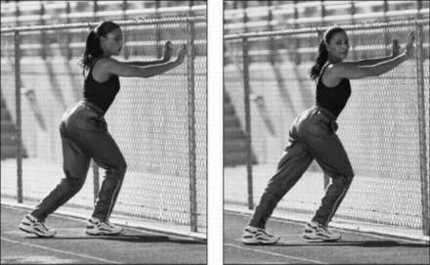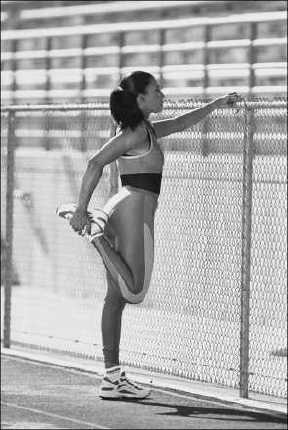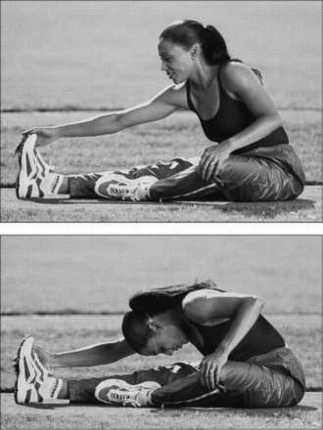A stretch is a stretch, right? Well, not really. Stretching and the different ways to stretch are topics of controversy among runners.
For the past 25 years, so-called static or gradual stretching has been considered the right way to stretch. This is a slow, gradual stretch that you hold for 15 to 30 seconds. You can choose from dozens of static stretches, for almost every major muscle group; some of the stretches are almost instinctive, like the arms-reaching-for-the-sky stretch that many of us do when we first wake up in the morning.
But recently, the stretching arena has become crowded with different and new forms of flexibility training:
- Ballistic stretching, which consists of those bouncing exercises that you used to do in your junior high gym class, seems to be making a comeback.
- A new form of stretching called active isolated (AI) has gained popularity in recent years, especially among athletes. Active isolated stretching involves brief contractions of the agonist muscle to help stretch the opposite, or antagonist, muscle (the quadriceps versus the hamstrings, say), sometimes by using a rope or chord to help.
- Other forms of stretching require the assistance of a trained "stretcher" (as in someone to stretch you, the "stretchee"). Stretching machines are now available on the market, too.
Some stretching techniques are new, and some are very old. Yoga, for example, is an ancient form of flexibility and relaxation exercise that has gained new converts among sore runners. Taking a yoga class is a wonderful complement to a running program.
You don't have to assume the lotus position to get the benefits of stretching — most experts agree that you can't really go wrong with static stretching.
Stretching: The truth
Here's how to perform a stretch. Get into the proper position and hold it for 15 to 30 seconds. Don't bounce or force the motion. Go as far as you can, without feeling pain. If you feel some mild tension, that's okay, but you should not be in pain. Repeat the stretch.
Remember that stretching is not a contest. Some people are naturally more flexible than others. But everybody can improve.
The flexible five
No, the "flexible five" are not some lanky, loose-jointed swing combo, but a regimen of five basic stretches that you can do if you're pressed for time. Do them every day, or at least on the days that you run.
Remember to stay relaxed while you stretch, and don't hold your breath. Breathe as you stretch.
- Calf stretch: Stretching guru Bob Anderson calls the calf "the second heart of the body" because the calf is a major circulation area in the push-off phase of the running motion. To stretch out the calf, lean against a wall with your forearms in front of you, as shown in Figure 1.
 |
Figure 1: The calf stretch. |
- Position your forward leg with your toe close to the wall. Bend the knee of your forward leg and slowly move your hips forward, keeping your lower back flat and the heel of your straight leg on the ground. Hold and repeat. Then do the other leg.
- Lower back, hip, groin, and hamstring stretch: This exercise is a simple and simply wonderful stretch for a runner, and you've probably done it thousands of times. Stand with your feet about shoulder width apart and pointed straight ahead. Slowly bend forward, keeping the knees "soft" (slightly bent).
- If you can touch your toes, fine. If you can't, fine. Feeling the stretch in your hamstrings and lower back is the key to this stretch.
- Quadriceps stretch: You've probably seen runners do the quadriceps stretch — and most of them are doing it incorrectly. They bend their upper bodies as if they're turning themselves over like teapots, using their leg as the handle.
- To do this stretch correctly, take your left foot with your right hand, while using your left hand to support your body against a wall. Gently pull your heel towards your backside, keeping the rest of the body straight. Feel the stretch in the quadriceps (thigh) muscles. Repeat with the other side, taking your right foot with your left hand.
- If you have particularly well-stretched quadriceps, you're likely to be able to grab your right foot with your right hand and your left foot with your left hand when you perform this stretch — all without losing your balance (see Figure 2).
 |
Figure 2: Stretching a quadricep. |
- Hamstring stretch: Because a runner's hamstrings (the large muscles in the back of the thigh) tend to get tight, loosen 'em up with this version of the classic old hurdler's stretch. From a seated position, extend your right leg and bend your left leg, touching the inside of your right thigh with the sole of the left foot. Grasp the part of your extended leg that you can comfortably reach, as shown in Figure 3.
 |
Figure 3: Stretching out a hamstring. |
- Some people can touch their foot, while others may not be able to reach much past their knee. Slowly and gently bend from the hip. Don't worry about being able to reach your toes or touch your chest to your leg. Just go as far as you can comfortably, feeling that stretch in your hamstrings. Then repeat, with left leg extended.
- Shoulders and neck stretch: Your upper body can get tense while you run, and it will definitely get tense if you do what most Americans do when not running — sit in front of a computer screen or a TV. So a little shoulder and neck stretch will help loosen you up all around.
- Raise the top of your shoulders towards your ears until you feel a slight tension in your neck and shoulders. Hold for 3 to 5 seconds and then relax your shoulders. Repeat several times.






